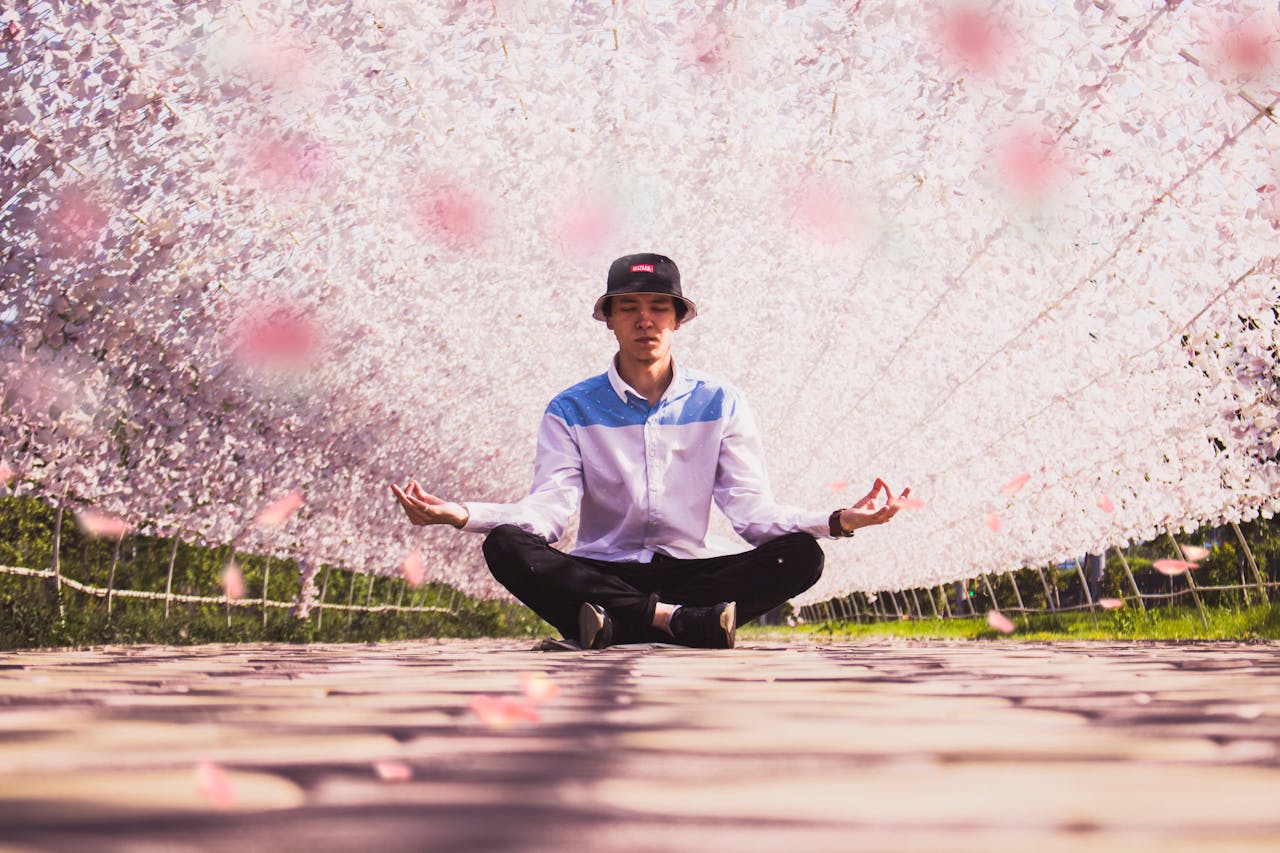
Table of Contents
Gain a clear understanding of meditation with this straightforward guide. Explore the basics and benefits of meditation, providing insights into the practice's calming effects on the mind and body. Elevate your well-being with a concise overview of the transformative power of meditation.
Key Takeaways
- Meditation promotes calmness, relaxation, and psychological balance, enhancing overall well-being.
- It offers significant health benefits, including stress reduction, improved sleep, and better emotional health.
- Various forms of meditation, such as Transcendental, Loving-Kindness, and Body Scan, cater to different needs and preferences.
- Regular meditation practice is accessible and can be integrated into daily life to maintain mental clarity and inner peace.
What is Meditation
Have you ever experienced feelings of anxiety, stress, and tension? You're not alone. Many people encounter these challenges.
Meditation is a practice with a long history of promoting calmness, physical relaxation, psychological balance, and overall well-being, and can offer relief.
Meditation is a mental practice that involves focusing your attention, becoming present, and releasing the thoughts that may crowd your mind. It encourages relaxation, mindfulness, and self-awareness, allowing you to attain a state of inner calm and mental clarity.
It may be hard to believe, but meditation is always accessible, allowing you to practice it anywhere and anytime.
The Benefits of Meditation
Scientific research suggests that there are extensive health benefits of meditation and mindfulness practices, both physical and mental.
Physical Benefits
Regular meditation practice can result in many physical benefits, including:
-
Reducing high blood pressure
-
Improving sleep quality and treating chronic insomnia
-
Decreasing symptoms of chronic pain
-
Improving energy levels
-
Improving immune system function
Mental Benefits
Many people practice meditation to achieve mental benefits, including:
-
Reducing stress
-
Improving anxiety disorders
-
Supporting acceptance of difficult emotions
-
Maintaining conscious awareness
-
Experiencing inner peace
Alternative Treatments
Meditation can be considered part of complementary and integrative health care as people often use meditation as an alternative medicine for certain physical and mental health conditions.
For example, meditation techniques have been used with cancer patients to help manage stress, alleviate treatment-related symptoms, and enhance their overall quality of life.
Additionally, meditation is being integrated into healthcare settings to address various mental health conditions, such as anxiety, depression, and post-traumatic stress disorder, offering a holistic approach to well-being.
How to Meditate
There are many meditation practices, but in the simplest form, you can meditate by finding a quiet space, focusing on your breath, and gently redirecting your attention when your mind wanders.
Here are six basic steps you can take to prepare for mindfulness practice of meditation:
-
Find a quiet space.
-
Get comfortable in a comfortable position on the floor or a chair.
-
Set a timer or consider using a guided meditation.
-
Begin to practice deep breathing to help ground your energy. Take a few deep breaths until you get into a rhythm, and continue.
-
Notice thoughts as they come and let them float away. When your mind wanders off on a train of thought, bring your focused attention back to present moment awareness through the sensation of your breath.
Although meditation will not always come easy, you will see quick progress if you begin practicing for just a few minutes daily.
You can carry mindfulness as a psychological tool to help center your mind. When stressed, take a few moments to reflect and practice breathing exercises. Although simple, these meditation techniques can go a long way.
Meditation centers offer guided mindfulness meditation training, commonly called mindfulness meditation programs, for those who prefer to learn from experienced coaches.
There is also an eight-week Mindfulness-Based Stress Reduction (MBSR) course, which is presently one of the most popular introductions to mindfulness meditation. As the creator of MBSR, Jon Kabat-Zinn, said: “You can’t stop the waves, but you can learn to surf.”
“Meditation and concentration are the way to a life of serenity” – Baba Ram Dass
Types of Meditation
There are numerous mindfulness meditation practices, and you must find one you enjoy.A basic meditation involving one of these meditative techniques along breathing exercises can be extremely beneficial.
Here are some meditative practices that are beneficial for physical and mental ease while supporting spiritual growth:
Transcendental Meditation
During transcendental meditation (TM), you silently repeat a mantra, a specific sound, for 20 minutes twice daily.
Research has demonstrated numerous benefits of this practice. Transcendental meditation allows your body to settle into profound rest and allows your mind to achieve more focus and inner peace through concentration.
Loving-Kindness Meditation

Loving-kindness meditation is a type of mantra practice and a powerful self-care tool that has you mentally send goodwill, kindness, and compassion to yourself and others through the silent repetition of beneficial phrases.
Body Scan Meditation
Body scan meditation is a simple practice that guides you to focus on each body part and the sensations that arise.
You will practice it in a systematic sequence from feet to head. Body centered meditation brings self-awareness to each body part and helps to reduce pain, tension, and other lingering feelings.
Mantra Meditation
Mantra meditation involves focusing on sitting silently and repeating a calming word, thought, or phrase, which helps to prevent distracting thoughts.
This style of meditation is prominent in religious traditions, including Hindu and Buddhist traditions.
Also, for example, repeating the Hail Mary prayer in the Catholic tradition has similarities to mantra meditation in its repetitive nature, and both practices aim to cultivate a sense of inner peace and spiritual connection through repetitive recitation.
Visualization Meditation
Visualization meditation involves focusing on something visual, holding it in your mind, and imagining the outcome becoming your reality. It could include visualizing your body or completing a goal, visualizing a white healing light, or visualizing a journey through nature.
This practice promotes a deep sense of relaxation and helps you harness the power of your mind to manifest positive changes in your life.
Guided Meditation
This introductory meditation helps create a foundation for beginners in meditation. A guide, teacher, or recording will lead you through the meditative practice.
Guided meditation and mindfulness training often direct you to engage your senses and form mental images of places or situations you find relaxing or helpful to process emotions. Sound is often an important element of guided meditation but is not always necessary.
Walking Meditation
Walking meditation involves drawing your attention inward as your body moves slowly and deliberately while your mind wanders.
Focus on the sensations of each step, such as the feeling of the feet making contact with the ground or the body's movement. It offers an opportunity to integrate mindfulness into daily activities.
Walking meditation improves awareness of your surroundings, helps you stay in the present moment, and can help with managing stress.
Mindful Meditation
Mindfulness meditation centers on being present and fully engaged with whatever you are doing at the moment. This practice involves sitting quietly and paying attention to thoughts, sounds, the sensations of breathing, or parts of the body. It's about noting the world around without immense reaction or judgment.
By focusing on the here and now, meditation technique helps manage stress by preventing the mind from over-engaging with past worries or future anxieties. This technique encourages acceptance of the current state, promoting calmness and improving emotional regulation.
Frequently Asked Questions
How do I stay consistent with my meditation practice?
Maintaining a consistent meditation practice involves setting achievable goals, finding a quiet space, and incorporating meditation into your daily routine at a convenient time.
Using alarms or meditation apps as reminders can help form a meditation habit.
It is also essential to accept that there may be times when you lose consistency with meditation practice, which is entirely normal.
Consider joining a meditation group for motivation and keep a journal to track your progress. The key is to integrate mindfulness into your daily life and build a habit that suits your lifestyle.
Are there any risks to practicing meditation?
Meditation is generally safe, but there are potential risks.
Meditation may unearth underlying emotional issues or discomfort for some, especially those with trauma or mental health concerns.
Overexertion during meditation practice can also lead to physical discomfort. It's advisable to consult a health professional before starting meditation practices.
References
Less stress, clearer thoughts with mindfulness meditation – Harvard Gazette
The neuroscience of mindfulness meditation
Mindfulness Meditation for Chronic Pain: Systematic Review and Meta-analysis
What Is Mindfulness Meditation?
Meditation: A simple, fast way to reduce stress
Disclaimer
The contents of this article are provided for informational purposes only and are not intended to substitute for professional medical advice, diagnosis, or treatment. It is always recommended to consult with a qualified healthcare provider before making any health-related changes or if you have any questions or concerns about your health. Anahana is not liable for any errors, omissions, or consequences that may occur from using the information provided.

By: Meriah McCauley
Meriah McCauley is a leading voice in holistic healing, known across North America for her expertise in chakra balancing, spiritual alignment, and energy-based wellness. Her work bridges the art and science of mind-body healing, shaped through years of study, practice, and mentorship. Meriah deepened her understanding of spiritual anatomy and the chakra system under the guidance of her guru, Dr. Don Stapleton, during her immersive training in Costa Rica. She later earned her Master’s degree in Psychology from Columbia University, specializing in Spirituality and the Mind–Body connection, which continues to influence her integrative approach. Today, she supports individuals and practitioners through coaching, yoga teacher trainings, chakra-focused education, and Holotropic Breathwork for personal transformation. Meriah is dedicated to helping others develop emotional clarity, energetic balance, and spiritual resilience—and she remains committed to guiding anyone seeking a deeper, more meaningful connection with themselves.